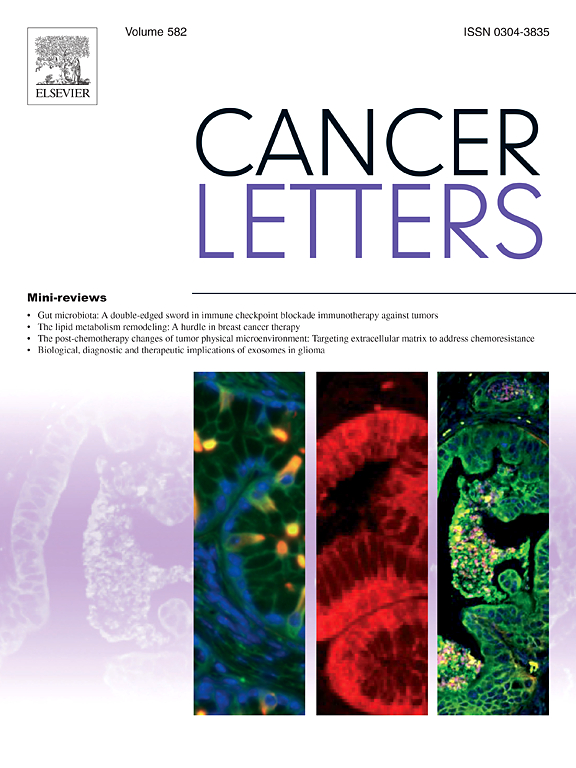Oncogenic HJURP enhancer promotes the aggressive behavior of triple-negative breast cancer in association with p53/E2F1/FOXM1-axis
IF 9.1
1区 医学
Q1 ONCOLOGY
引用次数: 0
Abstract
Triple-negative breast cancer (TNBC) represents the most aggressive subtype of breast cancer, lacking effective targeted therapies and presenting with a poor prognosis. In this study, we utilized the epigenomic landscape, TCGA database, and clinical samples to uncover the pivotal role of HJURP in TNBC. Our investigation revealed a strong correlation between elevated HJURP expression and unfavorable prognosis, metastatic progression, and late-stage of breast cancer. RNA-seq analysis indicated that HJURP silencing suppressed transcriptional signatures associated with malignant phenotypes of TNBC, thereby inhibiting cell proliferation, migration, invasion, epithelial-to-mesenchymal transition (EMT), and promoting apoptosis. Knockdown of HJURP impaired the growth of MDA-MB231-engrafted tumors, reducing KI67 and HJURP expression in the shHJURP group. Publicly available datasets showed differential expression of HJURP in TNBC cells harboring mutant p53 (mutp53) compared to those with wild-type p53 (wtp53), highlighting a potential mechanism underlying TNBC's aggressiveness. Mechanistically, we established that loss or mutation of wtp53 enhances HJURP expression, whereas wtp53 accumulation restrains HJURP transcription. We elucidated a regulatory axis where wtp53 positively modulates the transcription factors FOXM1 and E2F1, which form a complex with H3K27ac to bind preferentially to the HJURP enhancer, driving its transcription. CRISPR interference targeting the enhancer region resulted in diminished HJURP expression and phenotypes reminiscent of HJURP knockdown, accompanied by reduced binding of E2F1, FOXM1, and H3K27ac to the enhancer. In a translational perspective, we found marked decreases in survival of breast cancer patients expressing high HJURP levels carrying wtp53. Collectively, our findings identify enhancer-driven HJURP as a pivotal molecular bypass that suppresses the tumor-suppressive and pro-apoptotic effects of wtp53. Targeting HJURP presents a compelling therapeutic strategy to inhibit tumor proliferation, metastasis, and invasiveness specifically p53-mutant TNBC.
致癌HJURP增强子与p53/E2F1/ foxm1轴相关,可促进三阴性乳腺癌的侵袭性行为。
三阴性乳腺癌(TNBC)是最具侵袭性的乳腺癌亚型,缺乏有效的靶向治疗,预后较差。在这项研究中,我们利用表观基因组图谱、TCGA数据库和临床样本来揭示HJURP在TNBC中的关键作用。我们的研究显示HJURP表达升高与不良预后、转移进展和乳腺癌晚期有很强的相关性。RNA-seq分析表明,HJURP沉默可抑制与TNBC恶性表型相关的转录特征,从而抑制细胞增殖、迁移、侵袭、上皮-间质转化(EMT)和促进细胞凋亡。敲低HJURP抑制mda - mb231移植肿瘤的生长,降低KI67和HJURP在shHJURP组的表达。公开数据集显示,与野生型p53 (wtp53)相比,HJURP在携带突变型p53 (mutp53)的TNBC细胞中的表达存在差异,这突出了TNBC侵袭性的潜在机制。从机制上讲,我们确定wtp53的缺失或突变增强了HJURP的表达,而wtp53的积累抑制了HJURP的转录。我们阐明了一个调控轴,其中wtp53正向调节转录因子FOXM1和E2F1,这两个转录因子与H3K27ac形成复合物,优先结合到HJURP增强子上,驱动其转录。靶向增强子区域的CRISPR干扰导致HJURP表达减少,表型与HJURP敲低相似,同时E2F1、FOXM1和H3K27ac与增强子的结合减少。从翻译的角度来看,我们发现携带wtp53的高HJURP水平表达的乳腺癌患者的生存率显著降低。总的来说,我们的研究结果确定了增强子驱动的HJURP是抑制wtp53的肿瘤抑制和促凋亡作用的关键分子旁路。靶向HJURP是抑制肿瘤增殖、转移和侵袭性的有效治疗策略,特别是p53突变TNBC。
本文章由计算机程序翻译,如有差异,请以英文原文为准。
求助全文
约1分钟内获得全文
求助全文
来源期刊

Cancer letters
医学-肿瘤学
CiteScore
17.70
自引率
2.10%
发文量
427
审稿时长
15 days
期刊介绍:
Cancer Letters is a reputable international journal that serves as a platform for significant and original contributions in cancer research. The journal welcomes both full-length articles and Mini Reviews in the wide-ranging field of basic and translational oncology. Furthermore, it frequently presents Special Issues that shed light on current and topical areas in cancer research.
Cancer Letters is highly interested in various fundamental aspects that can cater to a diverse readership. These areas include the molecular genetics and cell biology of cancer, radiation biology, molecular pathology, hormones and cancer, viral oncology, metastasis, and chemoprevention. The journal actively focuses on experimental therapeutics, particularly the advancement of targeted therapies for personalized cancer medicine, such as metronomic chemotherapy.
By publishing groundbreaking research and promoting advancements in cancer treatments, Cancer Letters aims to actively contribute to the fight against cancer and the improvement of patient outcomes.
 求助内容:
求助内容: 应助结果提醒方式:
应助结果提醒方式:


